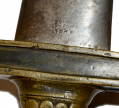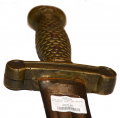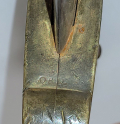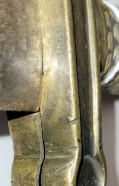site search
online catalog
AMES 1835 DATED FOOT ARTILLERY SHORT SWORD AND SCABBARD

$850.00 SOLD
Quantity Available: None
Item Code: 1249-01
Among the new standardized sword patterns adopted by the U.S. Army between 1832 and 1834 was a short sword modeled on the French 1816 pattern for artillerymen on foot. Looking like an ancient Roman gladius, the sword might have been useful to artillerymen for last-ditch personal defense, clearing ground for guns, and even cutting dead artillery horses out of their harness in action. In the U.S. army the sword was also designated in the early years for infantry sergeants and likely carried by musicians as well. An impressive looking sword, it was popular in militia organizations and aggressively marketed by Ames to the states, who could request it as part of their militia allotments, and it became a mainstay for Ames, remaining in production for thirty years.
This one is dated 1835, early in the production run, and is in about fair condition, showing use and rough handling. The hilt has an unpolished patina and good detail on the eagle decoration in the pommel and in the feathers of the grip. The rivets secured the hilt to the blade tang are brown. The guard on one side shows an open seam between the cast halves- perhaps indicative of some of the problems Ames had in early casting, and the blade now has a wobble. The inspection marks on the underside of the guard are partially visible. “H.K.C.” in an oval along the blade flat on side is very clear and the abbreviation “ORD” for “Ordnance” is visible near one edge, toward the tip of the guard, and what appears to be “JM” near the other. (See Thillmann, US Army Swords, p.43 for variations in 1835 markings.) The blade is full length and cleaned bright with some dark spots, fine shallow pitting and fine scratches, with the edges showing a lot of small nicks. The markings are rubbed, but partially legible. On one side of the base of the blade UNIT[ED] / ST[ATES] / 1835 is partly visible with the letters in brackets not visible and the date rubbed along the bottom, but unambiguous. The other side retains just a hint of the eagle, part of the Ames name: N[.P. AM]ES and the first three letters of Springfield, SPR…, just below it.
The black leather scabbard is complete with brass mounts in place, though the button stud on the throat was crudely replaced at some point, and solder shows around the base. The throat is missing one pin on the reverse. The drag is missing one on the reverse and one on the obverse is partially out. The finish has good color, but has some abrasions along the edges and cracking with one crease on flat. The seam is good and does not show any openings.
The 1835 production date places the sword among 2,400 contracted for in November 1834, delivered by late June 1835, or another 400, contracted for in February 1835 and delivered by the end of the year. An August 1, 1835, contract called for yet another 1,000, but they were delivered by June 1836, so many of those blades were probably 1836 products. For a full discussion of the pattern, history, variations, etc., see Thillmann’s CW Swords volume and follow-up articles in Man-at-Arms magazine, as well as Hickox’s “Collector’s Guide” to Ames contract swords. [sr][ph:L]
~~~~~~~~~~~~~~~~~~~~~~~~~~~~~~~~~~~
THIS ITEM, AS WITH ALL OTHER ITEMS AVAILABLE ON OUR WEB SITE,
MAY BE PURCHASED THROUGH OUR LAYAWAY PROGRAM.
CLICK HERE FOR OUR POLICIES AND TERMS.
THANK YOU!
Inquire About AMES 1835 DATED FOOT ARTILLERY SHORT SWORD AND SCABBARD
For inquiries, please email us at [email protected]
Most Popular
Historical Firearms Stolen From The National Civil War Museum In Harrisburg, Pa »
Theft From Gravesite Of Gen. John Reynolds »
Fine Condition Brass Infantry Bugle Insignia »
Selection Of Unframed Prints By Don Troiani »
Wonderful Condition Original Confederate-Manufactured Kepi For A Drummer Boy Or Child »
featured item
CAPTAIN W.W. RANDOLPH: LIKELY WILLIAM WELFORD RANDOLPH, 2nd VIRGINIA, LATER LT. COLONEL, KIA THE WILDERNESS 1864
Identified as Capt. W.W. Randolf (sic) in the files of the late Bill Turner, noted Virginia collector and dealer, this six plate ambrotype shows Randolph seated with one hand on his thigh and the other resting on a book atop a photographer’s table… (1138-1803). Learn More »




















